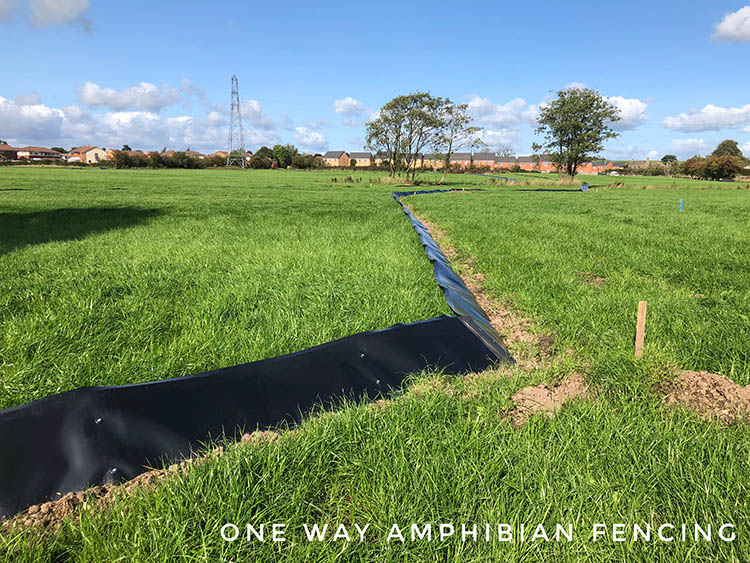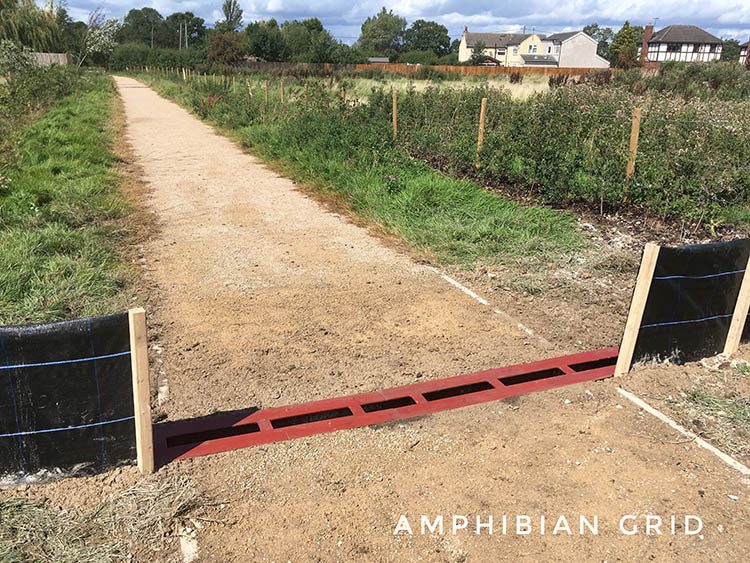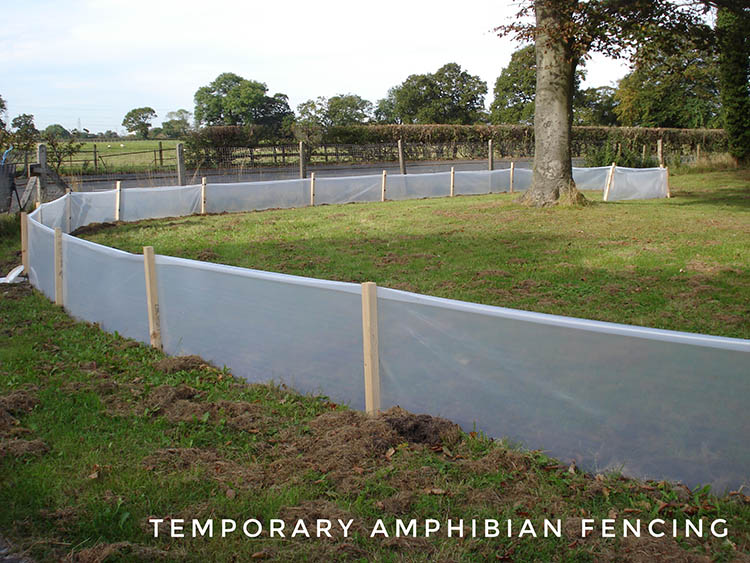Amphibian fencing
We have an established history of working with developers and their ecologists, installing amphibian fencing and trapping apparatus on great crested newt mitigation projects all over the UK.
Established in 2006, we have continued to develop our product range and installation techniques in order to offer the most efficient solutions for amphibian exclusion.

We offer an excellent choice of amphibian fencing based on budget, terrain and required durability.
But when our clients ask for quick delivery and superior quality on a tight budget, we recommend:
Geo Textile Exclusion Fencing – OUR BEST SELLER!
- Best Value. Our most popular amphibian fencing
- Long Life. UV treated to last 5-7 years
- Less Waste. Uses 96% less plastic than solid panel options
- High Quality. Robust Construction
- Excellent water dispersion. Eliminates water pooling and erosion of backfill

Alternative Amphibian Fencing Choices:
Temporary Exclusion Fencing:
- 1000 gauge polythene membrane for temporary and drift fencing installations
- UV treated to last 2 years
- Standard colour options are clear or green
- Custom colours are available to order
1mm Semi-Permanent Fencing:
- 1mm thick solid HDPE
- Made from recycled (re-granulated) materials
- UV stabilised
- Pre-scored with a 90 degree top and bottom baffle
- Suitable for robust temporary or semi-permanent usage
EcoFender™ Semi-Permanent Fencing:
- 2000 gauge twin reinforced heavy-duty polythene
- UV stabilised
- Uses 50% less plastic than our 1mm semi-permanent fencing option
- Flexible membrane. Can accommodate uneven ground and tree roots
- Suitable for robust temporary or semi-permanent usage
3mm Permanent Fencing:
- 3mm thick solid HDPE
- Made from recycled (re-granulated) materials
- UV stabilised
- Available in two height options: 850mm or 1000mm tall
- Self-supporting or where ground conditions require, can be braced using timber or plastic lumber posts
Newt Fencing
Pitfall Traps: We can supply and install pitfall traps on your mitigation scheme. We supply white HDPE buckets with a snap-shut lid and handle. We bury the handle front-facing to aid removal at end of life. All our pitfall traps are 100% recyclable. We can supply mammal ladders and floats to aid the welfare of captured animals whilst in the trap.
Artificial refugia: There are occasions when capture effort may need to be boosted by the use of artificial refugia. This can be in addition to the use of pitfall traps, or on terrain which does not allow for the correct citing of pitfall traps, such as hard standing or woodland. We can supply and install carpet tiles which are suitable for this purpose. Each measure 500mm x 500mm.
Newt Grids: we make newt grids to order based on your requirements. Custom sizing and colours. Fabricated from steel, our newt grids can take the strains of even the heaviest of regular plant crossing. Made in Lancashire.
Newt Gates: we make all our newt gates from scratch. Based on your site requirements, size, duration of use and budget. We can supply and install a free-standing newt gate or construct a newt proof baffle to existing gates where suitable. Feel free to get in touch to discuss your requirements.

Newt fencing for hardstanding areas: We’ve been installing wildlife fencing for various protected species since 2006. And we’ve tested various options for a secure fit across hard standing and roadways in that time. We have now produced a fast and effective solution for installing newt fencing across hard standing. Via a self-supported system. This allows us to use the same grade posts and post spacing as that specified within the Great Crested Newt Mitigation Guidelines. Our free standing system is secured using sealed sandbags to prevent animal ingress. It can be used with temporary and semi-permanent newt fencing membranes.
Toad fencing: Amphibian fencing and grids can also be used for toad mitigation projects. Toad fencing and newt fencing are the same product. Installed via the same process for the same purpose of excluding or containing amphibians in an area.
We are experienced in installing toad fencing for use in both natterjack toad and common toad mitigation schemes.
Natterjack toads are an incredibly rare species and works must typically be done under license. The common toad is a priority species. Using toad fencing as part of a capture and translocation scheme is becoming an increasingly popular method of mitigating impacts on large populations of this species, prior to development works.
Exclusion Fencing Terminology
Amphibian fencing is often called many different names. Newt fencing is the most common alternative name. Coined ‘newt fencing’ as most often the exclusion fencing is used in great crested newt mitigation schemes.
Temporary amphibian fencing or TAF just denotes the brief duration the fencing is required for. Typically, temporary amphibian fencing is in place for up to 2 years, for short construction programmes and ‘temporary’ works.
One way fencing is an exclusion fence which is installed at a 45-degree angle. The incline allows amphibians to climb out of the danger area. So long as vegetation cover is managed correctly, by means of ensuring it is kept short, the amphibians cannot return due to the acute angle. We have options for temporary and permanent one-way fencing. Including ACO one way convex fencing. Ask us for details.
Drift fencing is a term used for internal fencing which dissects the mitigation site into smaller compartments whilst the ecologists are capturing and moving the newts. Typically, the least expensive fencing membrane is used.
You can use semi-permanent and permanent amphibian fencing if you need to exclude newts from the area longer term.
Ultimately, no matter what it’s called, its purpose is the same.
How do newt and amphibian fencing work?
We’ll install exclusion fencing around the perimeter of your construction zone.
Ring-fencing the working area like this will stop any further herpetofauna getting into your site.
If the site is large, we will split it into smaller compartments using drift fencing. This increases the effectiveness of catching the newts.
Pitfall traps are used to capture the newts. The pitfall traps sit flush to the fence at regular intervals, at ground level.
Newts move overnight. And when they encounter a length of newt fencing they follow it until they drop into the pitfall trap. The ecologist will translocate the newts and other amphibians to a receptor site away from the development site
Correct installation is critical. We install all our newt and amphibian fencing in accordance with Natural England Great Crested Newt Mitigation Guidelines and the CIRIA Wildlife Fencing Design Guide.
To achieve correct installation, vegetation clearance may be required. Amphibian fencing requires a continuous trench as the material needs to be buried. This then forms a secure barrier which prevents animal ingress back into the working area.
Vegetation clearance will be needed if foliage obscures the trenching route. It is best practice to clear vegetation to a height of 150mm in advance of machinery movement, to minimise the risk of injury to any sheltering animals. Our operatives are qualified and experienced in this task.







